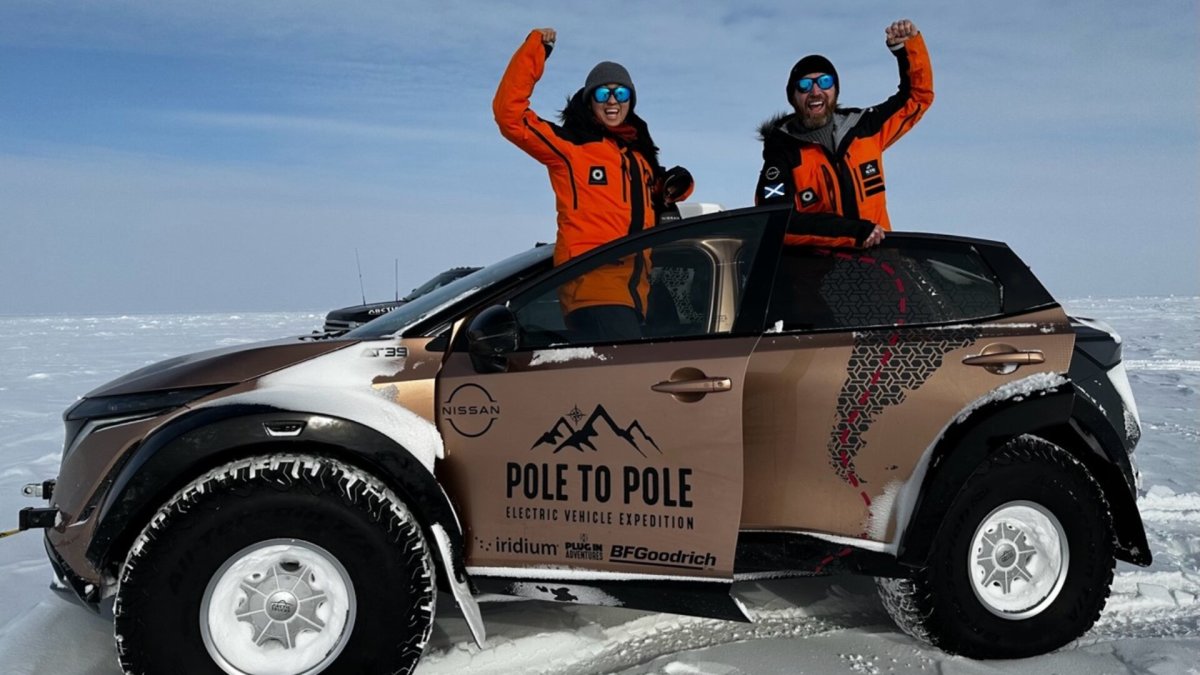
And you thought you had range anxiety.
Electric-vehicle owners know all too well that creeping sensation you get when you're buzzing along with one eye on the dashboard and the other one searching for a charging station. That concern is among the biggest factors holding back EV sales.
DON'T MISS: Tesla rival faces growing bankruptcy risk
One couple, Chris and Julie Ramsey, recently made a rather long trip in an electric vehicle. And when we say long, we mean record-breaking long.
The Scottish couple hopped into a modified Nissan (NSANY) -) Ariya electric crossover SUV and drove from the North Pole to the South Pole, marking the first time any vehicle — gas or electric — made this incredible journey.
We made it! After a tough and testing final leg of the expedition in Antarctica, we have finally finished. We arrived at the geographic & ceremonial South Poles on the 15th December 2023.
— Pole to Pole EV (@PoletoPoleEV) December 18, 2023
More updates to come 😀⚡️🚗#poletopoleev #nissanariya #nissan pic.twitter.com/qfh9pCaXjP
Electric-vehicle trip record: 9 months, 17K miles
The 17,000-mile trek began in March at 1823 Magnetic Pole and lasted nine months, covering three continents and passing through 14 countries.
All of a sudden, that holiday drive to your in-laws’ house doesn’t sound bad, does it?
“Our ambition is to capture hearts and minds and to show people that electric vehicles are the way forward,” Chris Ramsey said in a statement on the couple's website.
“We want to demonstrate that electric vehicles are capable of taking us on an incredible journey and that they don’t have to be seen as a sacrifice.”
The Ramseys do tend to get around. In 2017, the electric-power couple became the first team to complete the Mongol Rally in an all-electric vehicle.
In a modified Nissan Leaf the pair traveled more than 16,000 kilometers, or nearly 10,000 miles over 56 days, traversing multiple locales, including some places where people have never seen an EV.
The Pole to Pole Nissan was reengineered by Arctic Trucks, an Icelandic company that worked on the vehicle's frame, body, bodywork, underbody, steering and braking systems.
The company installed larger 39-inch tires plus matching wheel arches, but made no changes to the battery or powertrain.
Arctic Trucks called the mod the AT39, but the couple referred to their Ariya as "sonrisa," the Spanish word for smile.
Where did they get the juice to make this jaunt?
The record EV journey through the final leg
The trip through North America was relatively simple on highways with plenty of chargers.
But Electrek noted that the Ariya was significantly less efficient after modifications. Between the huge off-road tires, fenders, and roof rack with rooftop tent, its range was cut significantly.
South America proved more of a challenge, as the couple contended with less developed charging infrastructure, broken chargers and long stretches of unpaved road.
But on the plus side, the Pole to Pole expedition cooperated with Enel X to install chargers along the route.
Once in Antarctica, the couple met up with Arctic Trucks, which had also provided support during the Arctic portion of the trip.
"Expedition life here in Antarctica is a full-body workout in a gigantic freezer every morning and evening," one Instagram post read. "EV’s don’t like the cold but here we are demonstrating despite the extreme cold the Ariya still works and cope just fine."
The couple used either a 5kW wind turbine or a prototype solar hybrid charging solution to power their Ariya. And there were times when they had to fall back to their gas generator, which is required for traveling across the Arctic regions.
"We made it!" they tweeted on Dec. 17. "After a tough and testing final leg of the expedition in Antarctica, we have finally finished. We arrived at the geographic & ceremonial South Poles on the 15th December 2023."
- Action Alerts PLUS offers expert portfolio guidance to help you make informed investing decisions. Sign up now.







